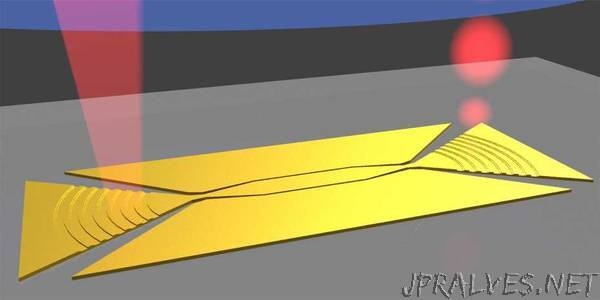
“Researchers at ETH Zurich have developed the first opto-electronic circuit component that works without glass and is instead made of metal. The component, referred to as a modulator, converts electrical data signals into optical signals. It is smaller and faster than current modulators, and much easier and cheaper to make.
Optical components for microelectronics must be made of glass. Metals are not suitable for this purpose, since optical data can propagate only across roughly a distance of 100 micrometres. This was the general view of scientists until recently. A team of researchers headed by Juerg Leuthold, professor in the Department of Information Technology and Electrical Engineering, has now succeeded in doing what was thought to be impossible and developed a light-processing component made of metal. The researchers have presented their findings in the latest issue of the journal Science.
They accomplished this feat by building a small enough component: at just 3 x 36 micrometres, it is within a size range in which both optical and electrical information can propagate in metals.
Component for fibre optic networks
The component is a modulator: modulators convert electrical data signals into optical signals. They are installed in modern internet routers used for fibre optic networks and enable fibre optic data connections between computer units in data centres. However, the standard components used today function differently than the new modulators.
The new component works by aiming the light from a fibre optic source at the modulator, causing the electrons on its surface to oscillate. Experts refer to this as a surface plasmon oscillation. This oscillation can be changed indirectly by electrical data pulses. When the oscillation of the electrons is converted back into light, the electrical information is now encoded onto the optical signal. This means that the information is converted from an electrical into an optical data pulse that can be transmitted via fibre optics.
Faster and smaller
Two years ago, Leuthold and his colleagues developed one of these plasmonic modulators (ETH News reported). At the time, it was the smallest and fastest modulator ever built, but the semiconductor chip still had various glass components.
By replacing all the glass components with metallic ones, the scientists have succeeded in building an even smaller modulator that works up to highest speed. “In metals, electrons can move at practically any speed, whereas the speed in glass is limited due to its physical properties,” says Masafumi Ayata, a doctoral student in Leuthold’s group and lead author of the study. In the experiment, the researchers succeeded in transmitting data at 116 gigabits per second. They are convinced that with further improvements, even higher data transfer rates will be possible.
Etched from a gold layer
The modulator prototype tested by the ETH researchers is made of a gold layer that lies on a glass surface. The scientists emphasised that the glass has no function. “Instead of the glass layer, we could also use other suitable smooth surfaces,” says Leuthold. It might also be possible to use less expensive copper instead of gold for industrial applications. The important point is that only one metallic coating is required for the new modulators. “This makes them much easier and cheaper to fabricate,” says Leuthold.
The researchers are already working with an industrial partner in order to put the new modulator into practice, and talks with other partners are in progress. However, Leuthold believes that further development may be required before the technology is ready for the market; for example, he expects that the current loss of signal strength during modulation can be reduced further.
For computers and autonomous vehicles
The new modulator could one day be used not only for telecommunications applications, but for computers as well. “The computer industry is considering using fibre optics to transfer data between the individual chips inside computers,” says Leuthold. However, this would require tiny modulators – such as Leuthold and his team have developed.
Ultimately, it is also conceivable that the modulators could be used in displays – including bendable ones – and optical sensors, such as those in the Lidar system for distance measurement that are used in (semi-) autonomous cars.”
